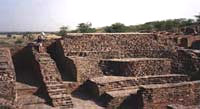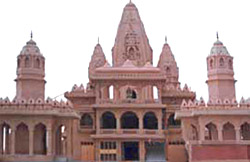Agroha is an ancient town in Haryana. It is located 20 Km`s North-West of the City of Hissar. The city was once very prosperous. Present day Agroha village is about 2.5 kms from the old Agroha City. The city is considered as the birthplace of the Agrahari and Agrawal community. Agroha was the capital of legendary Emperor Agrasen.
History of Agroha
Three thousand years back, Agroha was the kingdom of Maharaja Agrasen. The Agroha Mound or `Ther` is situated about 1.5 km away from the present Agroha village. Buried under this mound are the remains of the ancient town. Its excavation was started in the year 1888-89. It was at this time that people came to know about this great kingdom.
Agroha is situated in the district of Haryana and in it lies buried the ruins of the capital of the Agroha State. The ancient Agroha town existed some hundred years before the Kushan dynasty. Once the state was renowned for its prosperity. As time passed it could not stand the invasions of Greeks, Yavanas and Hunas. The invasions led to the migration of Agroha residents to other parts of India like Rajasthan, Uttar Pradesh, Punjab and Malwa. They people got the common name Aggarwals that means Agroha-Wale.
From the excavations it is clear that below the mounds existed a big, well planned and progressive town. Large number of silver and bronze coins of different shapes and sizes has been discovered from the excavated site. The scripts on the coins prove that they belong to different periods. Statues made of stone and sand was also excavated from the sites. There were many utensils belonging to the 2nd century BC.
Haryana and in it lies buried the ruins of the capital of the Agroha State. The ancient Agroha town existed some hundred years before the Kushan dynasty. Once the state was renowned for its prosperity. As time passed it could not stand the invasions of Greeks, Yavanas and Hunas. The invasions led to the migration of Agroha residents to other parts of India like Rajasthan, Uttar Pradesh, Punjab and Malwa. They people got the common name Aggarwals that means Agroha-Wale.
From the excavations it is clear that below the mounds existed a big, well planned and progressive town. Large number of silver and bronze coins of different shapes and sizes has been discovered from the excavated site. The scripts on the coins prove that they belong to different periods. Statues made of stone and sand was also excavated from the sites. There were many utensils belonging to the 2nd century BC.
 The Agroha Mountain goes back to the 3rd century BC and it is the place where Harappan coins were discovered apart from stone sculptures, terracotta seals, iron and copper implements, shells etc. The Agroha mound consists of the Agroha Temple Complex on one side and the Sheela Mata Temple on the other side.
The Agroha Mountain goes back to the 3rd century BC and it is the place where Harappan coins were discovered apart from stone sculptures, terracotta seals, iron and copper implements, shells etc. The Agroha mound consists of the Agroha Temple Complex on one side and the Sheela Mata Temple on the other side.
Places of attraction in Agroha
The places of attraction are:
The Temple Complex, which consists of three wings, the center of the complex is graced with the presence of Kuldevi Mahalaxmi. The dome of the Mahalaxmi temple is very big and the main `Kalash` of the temple is gold plated. In northwest wing of temple complex is the Saraswati Temple. The eastern wing of the temple complex hosts the temple of Maharaj Agrasen.
Shakti Sarovar is located at the back of the temple complex. The Sarovar is spread over an area of 4 acres and is filled with water brought from 41 holy rivers across India.



















